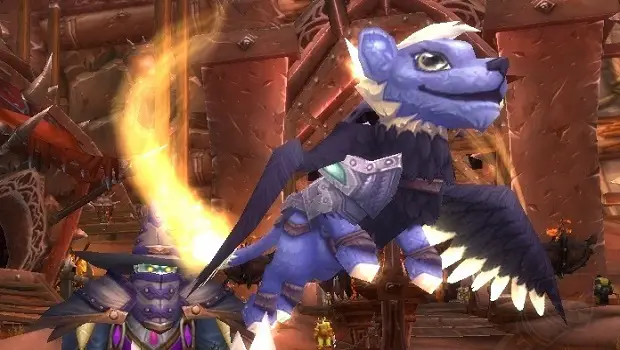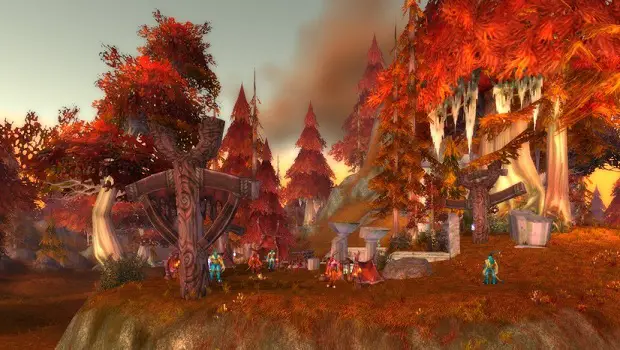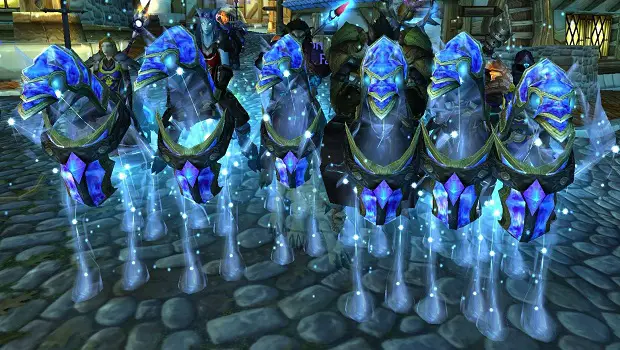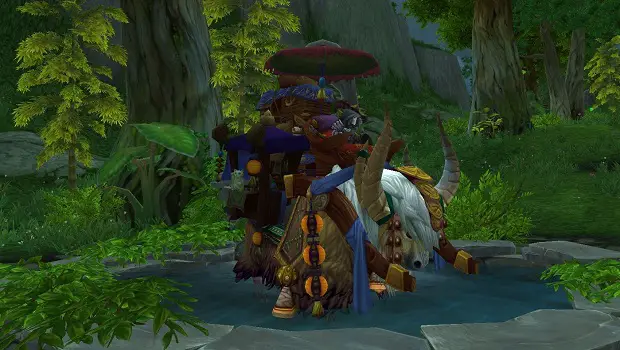WoW Archivist: Money and Warcraft

This past Tuesday, Blizzard introduced the WoW Token: an item that allows you to pay for your monthly subscription with gold. On the other end, it allows players to buy gold with real currency. With this one item, Blizzard has transformed both the real financial landscape of WoW and the fantasy economy of Azeroth.
To some this move was a surprise. If you look back at the history of real money in WoW, however, it feels more like an inevitable evolution. Let’s revisit how real money has intersected with the game and how it has all led up to the WoW Token.
Subscribing to a game?
Prior to the rise of MMOs, a subscription fee in gaming meant paying for a magazine like Electronic Gaming Monthly. Early online games like 1985’s Island of Kesmai had no fee, but service providers like CompuServe charged an hourly fee to access it: $12 per hour. (That’s a little over $26 in 2015 dollars!) After Internet access took on a monthly rate, so did games. Meridian 59 from 3DO was the first game to charge a monthly subscription beginning in 1996.
At the time of WoW‘s launch, among the biggest MMOs on the market were Ultima Online, Everquest, Asheron’s Call, and Final Fantasy XI. All charged a subscription fee. It seemed natural then for WoW to do the same, and few questioned the choice. Clearly the fee did not deter players from trying the game, and in many cases playing for months or years. WoW shattered records for both subscribers and sales over the next few years.
Over the past decade, many other games have tried to implement a subscription model: The Lord of the Rings Online, Rift, Age of Conan, Star Wars: The Old Republic, The Elder Scrolls Online, etc. All but a small handful have abandoned their monthly fee and have seen greater success as a result.
Despite so many games ditching the monthly sub model, WoW continues to charge for full access to the game. The game and its expansions also cost money to purchase. In terms of total cost, WoW is one of the most expensive MMOs on the market right now. So many play it anyway that Blizzard has no reason to reduce the price. In fact, the game has become more expensive. The price of expansions went up $10 for Warlords of Draenor, and odds are future expansions will cost the same or more.
In the first weeks of WoW, you often saw players fishing for hours at a time. You’d pass them angling near Bloodhoof Village in Mulgore. You’d quest around the zone and come back, and they’d be there. You’d log off for a few hours and log back in, and they’d be there, still catching fish. Believe it or not, these players were farming gold, often to sell for real currency on the “black market.”
Before players had leveled up, fishing was the best gold-per-hour activity in the game. Fishing was a far different profession in early WoW. You could frequently fish up gray items that vendored for a decent sum, as well as green items that could be auctioned for a nice profit. Even the fish themselves could be vendored for a respectable amount in those days. If you were willing to risk fishing in higher level areas, you could make a lot of cash without worrying about leveling or outfitting a character. Booty Bay was a great place to set up since you could fish without worrying about mob aggro. Gold farmers figured all this out early on. Many “real” players used fishing as a way to make gold, too.
Blizzard was not ignorant of this phenomenon. They took the nuclear option on fishing in December 2004 and disabled the profession completely in high level zones. For a time, that meant other professions like alchemy that depended on high level fish ingredients could no longer be leveled up. In patch 1.2, Blizzard restored fishing in all areas, but with severe nerfs. Fish sold for mere coppers. Catching nonfish items became extremely rare (and eventually it was eliminated altogether until future patches gradually brought it back). Blizzard also applied a minimum character level to advance to each new level of fishing. That way, you couldn’t max out the profession at level 1.
From farmers to hackers
After the nerf, the farmers moved on to other areas. One popular farming location was the cliffs above Azshara. It had a number of advantages. Quests were few, so intrepid adventurers rarely showed up to interfere with your mindless farming. The enemies there dropped the highest average amount of silver in the open world. You could also farm Felcloth from the satyrs. Felcloth could be turned into Mooncloth, which was a key ingredient in many epic tailoring recipes in classic WoW. Felcloth always sold.
When I was farming for my epic mount in 2005, I remember running into the Azshara farmers. They had strange names, they never accepted a party request, and they rarely responded to whispers. If so, they usually replied in broken English or with a noncommittal greeting. We always assumed they were playing in China, but people created gold-farming enterprises in many different countries around the world, including Mexico, Russia, and Indonesia.
As legitimate players gained more wealth, the farmers realized that farming was no longer the optimal path. It was far more efficient to hack accounts and steal the gold that had already been accumulated by “real” players. Once they got into your account, they sold everything you owned and sent all your gold to another account. You’d log in naked as the day your character was rolled, or more so. If your character had a fair amount of raid gear, they’d even drop one of your professions and level enchanting. Then they’d disenchant all your gear and send the valuable shards to another account, too. The stolen virtual cash then sold for real currency.
In the Burning Crusade and Wrath of the Lich King years, farmers became less and less common, while account hacks skyrocketed. One day, someone in my guild realized they’d been hacked after they couldn’t log in. They got on our Ventrilo server and asked us if their character was logged in. It was. The hacker hadn’t even dropped out of the guild yet — probably to lift what he could from our guild bank, too. (I kicked him as soon as I heard about it.) As our guildmate sat helplessly, we described in excruciating detail how his hacked toon was leveling enchanting, disenchanting his hard-earned raid gear, and vendoring everything else. It was part hilarious and part heartbreaking. At the time, restoring accounts post-hack often took Blizzard’s customer service weeks.
To combat the scourge of hacks, Blizzard introduced the first account authenticators in the summer of 2008. They were available only in “key fob” format. At first they were very difficult to get. They sold out as soon as Blizzard received a new batch from their manufacturer. Later Blizzard offered a phone app as an alternative.
Hackers continued to prey on unprotected accounts. In 2011, Blizzard filed complaints against PayPal for allowing gold sellers to use their service. PayPal was one of the most common methods of payment for such transactions. PayPal honored the complaints and began to ban gold sellers from using their service.
Even so, gold sellers kept at it.
Sparkle ponies just, like, everywhere
In the meantime, Blizzard decided to give players additional options and services, in some cases long-requested ones — but at a premium.
During the fall of 2009, Blizzard rolled out a host of new services and vanity items that could be purchased with real cash. They added the option to change factions in September 2009 for $30. Two months later came the ability to request a total character makeover — your race, appearance, and name — for a real-world fee. A week after that, Blizzard unveiled the Pet Store. The first two pets available were the Pandaren Monk and Lil’ K.T. Both cost $10, although Blizzard donated half of their profits for Monk purchases to the Make-a-Wish Foundation through the end of that year.
The following year came the Celestial Steed. The first mount offered for real money sold for $25. Some players balked at the steep price tag for a vanity item. Bloggers railed against the slippery slope of paying for “content” in a game you already pay real money to play. Others embraced the “sparkle pony” with open arms. The Steed made $2 million in its first four hours on sale. At the time, it was nearly impossible to visit a populous city without spotting a Celestial Steed or ten. Blizzard obviously considered the mount a success, since they went on to create eight others for purchase.
Other pets were also added, some with charitable donations attached. The Cenarion Hatchling raised $1.9 million in relief after a tsunami struck Japan in 2011. The Cinder Kitten took on Hurricane Sandy after the “superstorm” devastated the Caribbean and the eastern seaboard of North America in 2012. Argi helped the Red Cross fight an ebola outbreak in Africa in 2014.
In 2013, the Blizzard Store became fully integrated into the game. The first and so far only service that Blizzard added to the in-game store is the level 90 character boost, first offered in 2014. Initially controversial, the option to pay for levels raised many questions. Does it constitute “pay to win”? Aren’t we just paying Blizzard not to play their game? Is $60 too much? Is it bad for the game when players can skip so much content? The boost is still too new to answer those questions for certain, but as a veteran player and a raider I’m glad I have that option if I need it.
Guardians of the currency
During Cataclysm, Blizzard introduced a new and unique pet in their store: the Guardian Cub. Unlike other pets, this one didn’t bind to your account. You could sell the Cub to other players. Effectively, this meant you could “buy gold” from Blizzard for the first time.
The Guardian Cub saw some success as an experimental first option, but the item choice was flawed. These days, a player only needs to buy one of each pet per account. Also, the number of players who would spend so much gold on a pet is a small subset of a realm’s population.
However, the Cub did prove that some players would spend real money to buy gold if they had a legitimate way to do it. Blizzard just needed a better commodity to offer — an item that players would always want, no matter what. When Blizzard announced they were discontinuing the Guardian Cub in 2014, it seemed likely that they had such an item in the works. Last month they announced it: WoW Tokens.
Token offering
The day WoW Tokens went live on my realm (Khadgar-US), they were listed on the auction house for about 31,000 gold. By the next day, supply outpaced demand and they had dropped to 22,000. Some players are buying them, however. Our own Alex Ziebart has already funded his sub through 2016 with tokens.
WoW gold has always had a real-world value. Now, however, it’s no longer a risky and illicit market. It puts the gold farmers/hackers on notice and possibly out of business someday, at least when it comes to WoW. That could translate into fewer hacked accounts and less spam in trade channels or whispers. It will also potentially reduce inflation since hacked gold often means duplicated gold.
Unfortunately, these advantages come with their own price: players can no longer view WoW gold as a currency for in-game purposes. At the current values on my realm, for example, the Grand Expedition Yak now costs about $120! The real-world price of such “gold sink” type items will make many players pause before purchasing, now and in the future. That could also slow sales of expensive player-created items like Vial of the Sands. Meanwhile, more players are likely to attempt crafting them since they can now make real-world profits from the auction house. It will be very interesting to see how the Token affects realm economies in the future.
It’s all been leading to this: from the authenticators to the Guardian Cub to WoW Tokens. Is this the end of the road for real money in WoW? It feels like a logical end point, but with Blizzard you can never say never. What other items or services would you like to see offered for real money?
Please consider supporting our Patreon!
Join the Discussion
Blizzard Watch is a safe space for all readers. By leaving comments on this site you agree to follow our commenting and community guidelines.
 @QuestVendor
@QuestVendor







